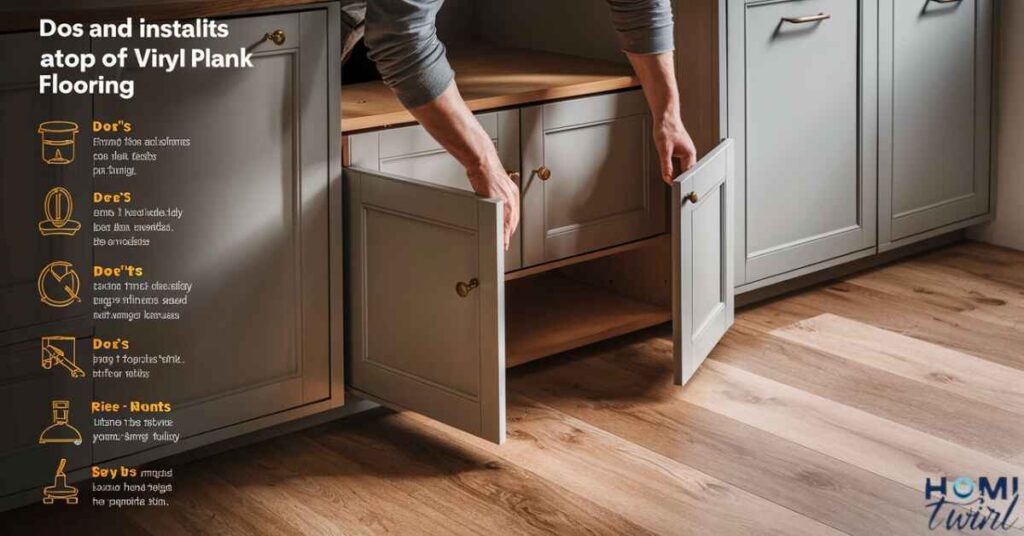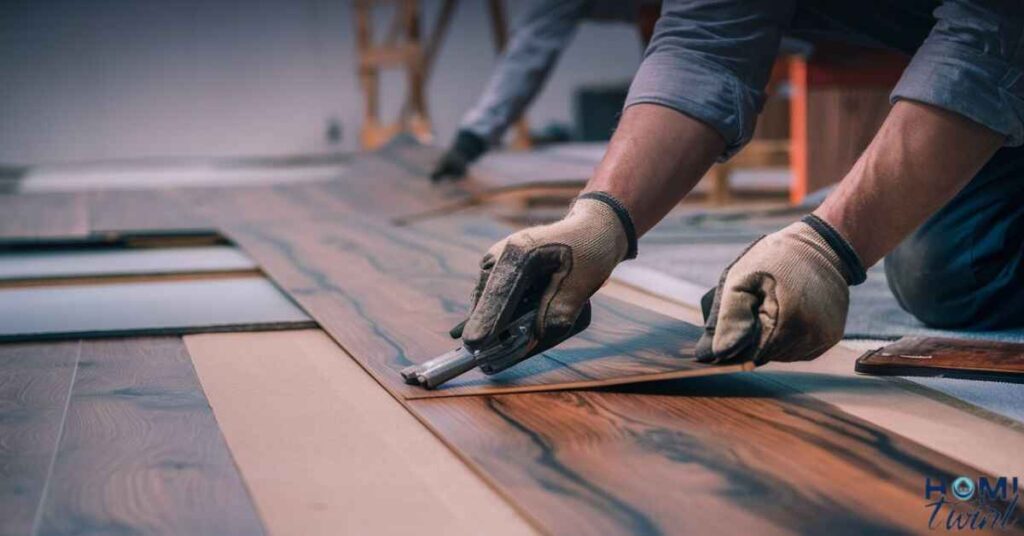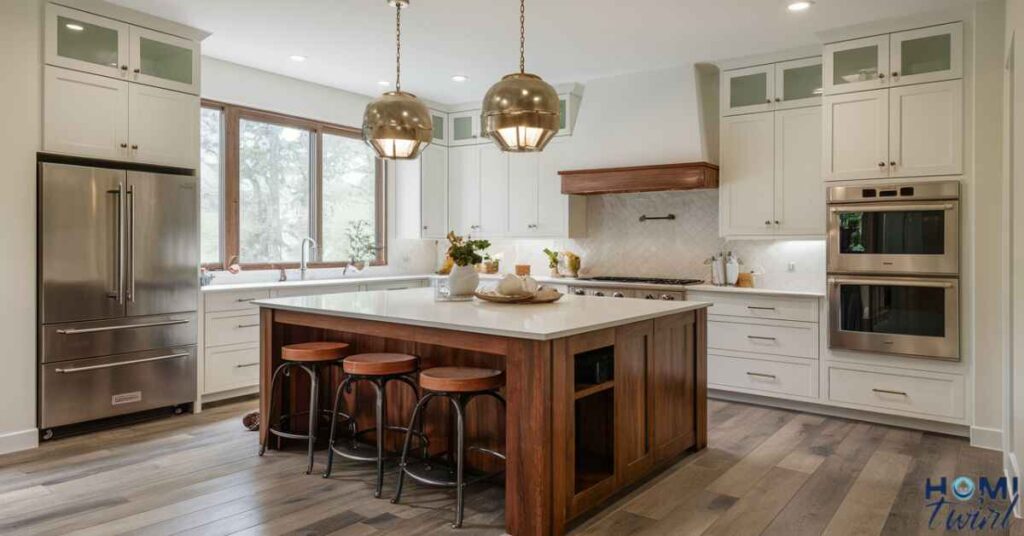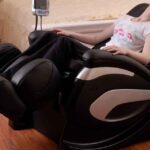Vinyl plank flooring has become increasingly popular in recent years, thanks to its durability, water resistance, and versatile designs that mimic the look of hardwood or tile.
Meanwhile, cabinetry plays a pivotal role in defining the functionality and aesthetics of kitchens, bathrooms, and other living areas. When it comes to combining these two elements.
It’s essential to consider factors such as the type of vinyl flooring installation, the weight and design of the cabinets, and the potential impact on the flooring’s performance.
Can You Install Cabinets On Top Of Vinyl Plank Flooring? The Dos and Don’ts Explained

Installing new flooring and cabinetry can breathe new life into your living spaces, but it’s crucial to understand the compatibility between these two elements. In this comprehensive guide, we’ll dive deep into the question, “Can you install cabinets on top of vinyl plank flooring?” and explore the best practices for a seamless and long-lasting installation.
Read This Blog: ARE ONE DAY BATHROOM REMODELS WORTH IT
Click-Lock Installation
Click-lock vinyl plank flooring, also known as a floating floor, is installed by locking the planks together without adhering them to the subfloor. This installation method allows for flexibility and expansion/contraction with temperature changes.
However, placing heavy cabinetry directly on top of a click-lock vinyl floor can inhibit its ability to expand and contract, leading to potential issues such as buckling, plank separation, or damage to the locking system.
It’s generally recommended not to install cabinets on top of click-lock vinyl plank flooring. Instead, consider the following options.
- Install the vinyl flooring first, then add the cabinets: This approach allows the flooring to “float” freely, minimizing the risk of buckling or damage caused by the weight of the cabinets.
- Use floating cabinetry: Floating cabinetry, often used in bathrooms and laundry rooms, is designed to sit on top of the flooring without being secured to the walls or subfloor. This option allows the vinyl planks to expand and contract as needed.
- Invest in felt pads: If you must have furniture or furnishings on top of your click-lock vinyl flooring, use felt pads or furniture sliders to protect the surface and allow for minor movements without causing damage.
The key to a successful click-lock vinyl plank installation is allowing the flooring to ‘breathe’ and move freely with temperature fluctuations,” says Sarah Johnson, a professional flooring installer. “Placing heavy cabinetry directly on top can compromise the integrity of the locking system and lead to unsightly gaps or buckling.
Glue-Down Installation

In contrast to click-lock installation, glue-down vinyl plank flooring is adhered directly to the subfloor using a specialized adhesive. This installation method eliminates the need for expansion and contraction, as the planks are firmly secured in place.
Also Read This Blog:
With glue-down vinyl plank flooring, it is generally safe to install cabinets on top of the flooring. However, it’s crucial to follow these best practices.
- Prepare the subfloor properly: Ensure that the subfloor is clean, level, and free of any debris or contaminants that could compromise the adhesive’s performance.
- Use the recommended adhesive: Follow the manufacturer’s instructions and use the recommended adhesive for your specific vinyl plank flooring product.
- Allow for proper curing: After installation, allow the adhesive to cure fully according to the manufacturer’s guidelines before placing any heavy cabinets on top of the flooring.
- Consider the cabinet weight and design: While glue-down vinyl plank flooring can support the weight of cabinets, it’s essential to consider the overall weight distribution and cabinet design. Excessive weight or concentrated pressure points can potentially cause indentations or damage over time.
- Protect the flooring: Use felt pads or furniture sliders under the cabinets to prevent scratches or scuffs when moving them, and avoid dragging heavy objects across the vinyl surface.
| Installation Type | Can Install Cabinets? | Precautions |
| Click-Lock | Not recommended | Allow for expansion/contraction, use floating cabinets or install flooring first |
| Glue-Down | Yes, with proper preparation | Prepare subfloor, use recommended adhesive, allow for curing, consider cabinet weight |
Other Considerations

While the installation type is a crucial factor in determining whether you can install cabinets on top of vinyl plank flooring, there are a few additional considerations to keep in mind.
- Subfloor condition: Ensure that your subfloor is level, clean, and free of any defects or moisture issues before installing vinyl planks or cabinets.
- Flooring thickness: Thicker vinyl planks may be better suited to withstand the weight of cabinetry, while thinner planks could be more prone to indentations or damage.
- Cabinet style and weight distribution: The design and weight distribution of your cabinets can impact the stress placed on the vinyl flooring. Opt for well-constructed cabinets with evenly distributed weight.
- Temperature and humidity control: Maintaining stable temperature and humidity levels in your home can help prevent excessive expansion or contraction of vinyl flooring, minimizing potential issues.
- Maintenance and cleaning: Regular cleaning and maintenance of your vinyl flooring, especially in high-traffic areas around cabinets, can help extend its lifespan and maintain its appearance.
Frequently Asked Question
Can I install cabinets on top of click-lock vinyl plank flooring?
No, it’s not recommended to install cabinets directly on click-lock vinyl flooring. The floating nature of the installation requires room for expansion and contraction.
What issues can arise if I install cabinets on click-lock vinyl flooring?
Installing cabinets on click-lock vinyl can lead to buckling, plank separation, or damage to the locking system. The weight of the cabinets inhibits the flooring’s ability to expand and contract.
Is it okay to install cabinets on top of glue-down vinyl plank flooring?
Yes, it is generally safe to install cabinets on top of glue-down vinyl plank flooring. The planks are adhered to the subfloor, eliminating the need for expansion and contraction.
What precautions should I take when installing cabinets on glue-down vinyl?
Ensure proper subfloor preparation, use the recommended adhesive, allow for full curing, and consider cabinet weight distribution. Protect the vinyl surface from scratches or scuffs when moving cabinets.
Can furniture be placed on top of vinyl plank flooring?
Yes, furniture can be placed on vinyl plank flooring, but it’s recommended to use felt pads or furniture sliders. This protects the surface and allows for minor movements without causing damage.
How does temperature affect vinyl plank flooring installations?
Temperature changes can cause vinyl planks to expand or contract, especially in click-lock installations. Maintaining stable temperatures and humidity levels is crucial for optimal performance.
What should I do if my vinyl flooring is discontinued?
If your vinyl flooring is discontinued, carefully document the product details and consult with the manufacturer or retailer. They may be able to suggest compatible alternatives or provide guidance on sourcing additional planks.
Can I install vinyl plank flooring around existing cabinets?
Yes, you can install vinyl plank flooring around existing cabinets by carefully measuring and cutting the planks to fit. Consider removing the cabinets for easier installation, then reinstalling them on top of the new flooring.
Conclusion
Installing cabinets on top of vinyl plank flooring is possible, but it depends on the installation type and adherence to best practices. Click-lock vinyl flooring requires caution to prevent buckling or damage, while glue-down installations can generally accommodate cabinetry with proper subfloor preparation and consideration of cabinet weight.
Remember, consulting with professional flooring installers or manufacturers can provide valuable insights and ensure a successful installation that meets your specific needs. Don’t hesitate to share your experiences or ask additional questions in the comments below.







